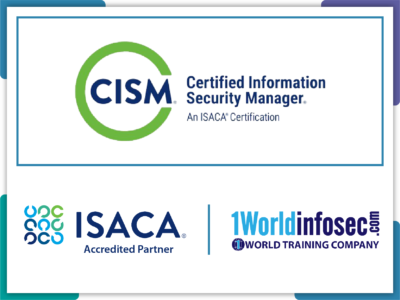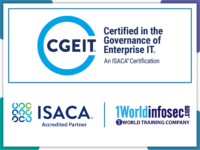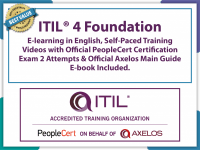Course Overview
The Certified Information Security Manager (CISM) course provides in-depth coverage of the four domains covered on the CISM certification exam: Security Governance; Risk Management and Compliance; Security Program Development and Management; and Security Incident Management. This course provides the knowledge on how to assess risks, implement effective governance and proactively respond to incidents.
Who Should Attend
The CISM security certification is designed for mid-level and advanced cybersecurity professionals with prior experience in information security. This certification helps professionals progress into managerial roles and effectively address challenges in information security. The course is ideal for the following roles:
-
- Information security managers
- Information security consultants
- Chief Information Officers (CIOs)
- Chief Information Security Officers (CISOs)
By earning an ISACA CISM certification, you will demonstrate your expertise in assessing and designing information security management programs. This enables you to advance your career while gaining the knowledge and skills needed to tackle cyber threats, making you a highly desirable candidate for employers in the field.
Course Content:
Module 1: Information Security Governance
In this module, you will learn how to:
- Establish and maintain an information security strategy and align the strategy with corporate governance
- Identify internal and external influences to the organization
- Define roles and responsibilities
- Establish, monitor, evaluate, and report metrics
Module 2: Information Risk Management and Compliance
In this module, you will learn how to:
- Establish a process for information asset classification and ownership
- Identify legal, regulatory, organizational, and other applicable requirements
- Ensure that risk assessments, vulnerability assessments, and threat analyses are conducted periodically
- Determine appropriate risk treatment options
- Evaluate information security controls
- Identify the gap between current and desired risk levels
- Integrate information risk management into business and IT processes
- Monitor existing risk
- Report noncompliance and other changes in information risk
Module 3: Information Security Program Development and Management
In this module, you will learn how to:
- Establish and maintain the information security program
- Identify, acquire, manage, and define requirements for internal and external resources
- Establish and maintain information security architectures
- Establish, communicate, and maintain organizational information security standards, procedures, and guidelines
- Establish and maintain a program for information security awareness and training
- Integrate information security requirements into organizational processes, as well as into contracts and activities of third parties
- Establish, monitor, and periodically report program management and operational metrics
Module 4: Information Security Incident Management
In this module, you will learn how to:
- Establish and maintain an organizational definition and severity hierarchy for information security incidents
- Establish and maintain an incident response plan
- Develop and implement processes to ensure timely identification of information security incidents
- Establish and maintain processes to investigate and document information security incidents
- Establish and maintain incident escalation and notification processes
- Organize, train, and equip teams to effectively respond to information security incidents
- Test and review the incident response plan periodically
- Establish and maintain communication plans and processes
- Conduct post-incident reviews
- Establish and maintain integration among the incident response plan, disaster recovery plan, and business continuity plan
Course objectives:
The course is designed to help individuals successfully pass the CISM certification exam while also equipping them to develop an effective information security strategy. Participants will learn how to implement the strategy, manage and monitor information security risks, and create and maintain an information security plan.
Prerequisites for the course:
To succeed in this course and pass the CISM exam, individuals should have at least five years of information security experience in one of the roles such as:
- IT consultant
- Auditor
- Manager
- Security policy writer
- Privacy officer
- Information security officer
- Network administrator
- Security device administrator
- Security engineer
CISM Training Camp Syllabus
Day 1 – Information Security Governance
A
- Welcome and Introduction to ISACA CISM Boot Camp
- Overview of ISACA CISM Exam Format and Study Strategy
- Information Security Governance
- Organizational Culture
B
- Legal, Regulatory and Contractual Requirements
- Organizational Structures, Roles and Responsibilities
- Information Security Strategy Development
- Information Governance Frameworks and Standards
- Strategic Planning (e.g., Budgets, Resources, Business Case)
Day 2 – Information Risk Management
A
- Information Security Risk Management
- Emerging Risk and Threat Landscape
- Vulnerability and Control Deficiency Analysis
- Risk Assessment and Analysis
B
- Risk Treatment / Risk Response Options
- Risk and Control Ownership
- Risk Monitoring and Reporting
Day 3 – Information Security Program
A
- Information Security Program
- Information Security Program Resources (e.g., People, Tools, Technologies)
- Information Asset Identification and Classification
- Industry Standards and Frameworks for Information Security
- Information Security Policies, Procedures and Guidelines
- Information Security Program Metrics
- Information Security Control Design and Selection
B
- Information Security Control Implementation and Integrations
- Information Security Control Testing and Evaluation
- Information Security Awareness and Training
- Management of External Services (e.g., Providers, Suppliers, Third Parties, Fourth Parties)
- Information Security Program Communications and Reporting
Day 4 – Information Security Incident Management
A
- Incident Management
- Incident Response Plan
- Business Impact Analysis (BIA)
- Business Continuity Plan (BCP)
- Disaster Recovery Plan (DRP)
- Incident Classification/Categorization
- Incident Management Training, Testing and Evaluation
B
- Incident Management Tools and Techniques
- Incident Investigation and Evaluation
- Incident Containment Methods
- Incident Response Communications (e.g., Reporting, Notification, Escalation)
- Incident Eradication and Recovery
- Post-Incident Review Practices







